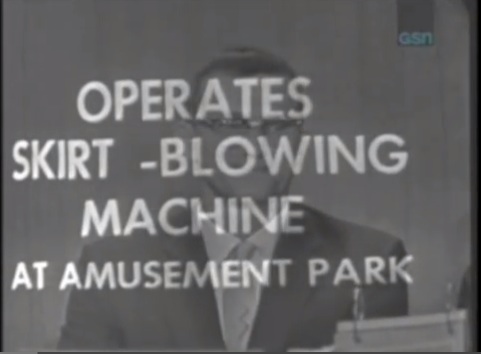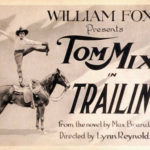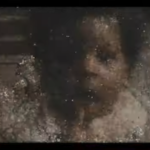The Guilty Pleasure of Wallowing in Quasi-Archives Constructed in Thoroughly Disapproved Ways
By Peter Monaghan
You could say that YouTube is to archiving as a hootenanny is to a cotillion. The first is wild and free, albeit ragged, while the latter is formal, mannered, structured… and dull, but only for those who lack the imagination.
Not just YouTube. We’re talking: all the anarchic or crazed online aggregations of largely uncurated, uncatalogued miscellanea in which one may wallow for weeks and still idle after more.
The emergence of behemoth, youtuberous anti-archives seems a triumph for everything the copybook archivist does not champion: it is not regulated by the exacting requirements, considered purpose, and patient detail-orientation valued in the archivist’s trade.
Properly maintained modern archives may be key-word searchable, and they may be linked to samples of moving-image items, or even whole items. But they do not sprawl like a mad dog’s dinner. Even when searchable, they ideally are constructed with precision and care, because that is what makes them optimally useful.
If you undertake studies in the storage, conservation, and restoration of moving-image material, one of the first things you’ll likely be assigned to read will warn you against the “just-drop-your-files-anywhere-and-hope-for-the-best-later attitude.”
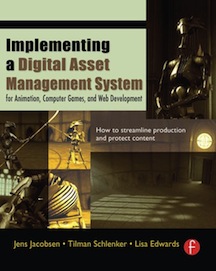 “Random workflow patterns and haphazard sign-offs” will drive you to distraction, caution Jacobsen, et al. in their 2005 textbook Implementing a Digital Asset Management System for Animation, Computer Games, and Web Development. They warn that if you adopt a haphazard approach to data organization — one that ensures that you have “no way to trace changes and garbled communication lines” — you may find yourself resorting to “crossing your fingers” in the hope that, for example, “the right version of the file ended up in the final product.”
“Random workflow patterns and haphazard sign-offs” will drive you to distraction, caution Jacobsen, et al. in their 2005 textbook Implementing a Digital Asset Management System for Animation, Computer Games, and Web Development. They warn that if you adopt a haphazard approach to data organization — one that ensures that you have “no way to trace changes and garbled communication lines” — you may find yourself resorting to “crossing your fingers” in the hope that, for example, “the right version of the file ended up in the final product.”
Presumably Jacobsen, Schlenker, and Edwards, whose book is an introductory text for aspiring workers in the information sciences, would pause if you told them you were creating, or merely placing faith in, or merely stooping to frequent a massive, amorphous dump of digitized video files. “What,” they might exclaim, “you’re talking about a storehouse as leaky as a sieve where you have little or no control over the formatting, indexing, image quality, or other key aspects of the aggregated material.”
In archiving film or any audiovisual material, it’s like your mother always said: “Will you please tidy up after yourself.”
(YouTube takes down material according to a formula that seems to allow any poster to place any two items in breach of copyright, but not three, with little fear of censure.)
As a cursory browse through posted items reveals, the posters don’t have to record precisely or correctly, and aren’t particularly inclined to record precisely or correctly, any of the “metadata” that are the lifeblood of the information sciences: collection or identification of information and then its cataloguing, classification, organization, storage, retrieval, interpretation, transformation, dissemination, and utilization of information in libraries, museums, and archives.
You’d soon learn if you were setting out on a career in archiving or a related field that posters to YouTube and its like decidedly do not often satisfy pretty much any of the requirements of those information-involved professions. The laundry list of proper, exacting processing of any collected information or objects is long; the list of those satisfied by your typical youtuber is exceedingly short.
You would assume that, without that data, information services and products will be lacking — and, that shortcomings in metadata will hinder computer engineers and information theorists who figure out uses for the properties and behaviors of information.
 Not that they aren’t trying. Google, for example, has a team of engineers and others who are studying the haphazard nature of online postings to see what conclusions they can draw that help them to develop useful theoretical or conceptual approaches to acting on, accessing, or using such information.
Not that they aren’t trying. Google, for example, has a team of engineers and others who are studying the haphazard nature of online postings to see what conclusions they can draw that help them to develop useful theoretical or conceptual approaches to acting on, accessing, or using such information.
In a paper published by Google, Vincent Simonet of Google Paris describes his and colleagues’ efforts to build a framework for categorizing YouTube channels of videos “in a thematic taxonomy with high precision and coverage.” They proposed that videos first be annotated by terms describing their central topics; that those terms be classified in one or more categories; and that the results of those first two steps be combined as a way categorize channels.
Nothing too arcane about that. You just see what is in each video, assign it key words, and soon you’re off to the races.
Simonet notes, however, that “this framework has been deployed on the whole corpus of YouTube, in 8 languages, and used to build several user facing products.” And very quickly the obvious question arises – poses itself, really: “How to do this at the scale of the YouTube corpus?”
How he goes about arriving at means to do so is beyond the scope of this essay, in part because it’s unlikely I’d be able to make or tail of Simonet’s academic-journal article. But if I do, I’ll let you know, another time. It may be, after all, that when information theorists and engineers do their thing, the dog’s-dinner nature of the youtubes does not clog the works as much as one might think. They apparently get to work theorizing around shambolic data sets such as the youtubes’, qua shambolic data sets.
It is hard to imagine what the theorizing would seek to clarify. Conceivably Simonet et al can arrive at methods for making something of the fungal propagation of 73 million cat videos and near as many of humans doing remarkably stupid things to themselves. The technicians and theoreticians who grapple large data sets must have ways of making something even of a frightful, swirling torrent of cultural waste and detritus.
To recap: Odds and sods posted to the youtubes by people who often appear to find spelling a severe challenge are suspect in various ways. Their clips, snippets, and now increasingly large items including whole feature films, news programs, television-show episodes — the lot — don’t go up online with any of the fastidiousness that archiving demands and generates. But…?
But the youtubes have emerged as addled-memory-machines — and that was all this column was intended to be about. But, just to conclude the preceding prelude: Artifacts such as film, television, and video clips and segments of increasing length pop up online. The theoretical and practical handling of that raw material is no simple matter. It entails, certainly, far more than archivists’ and librarians’ family members and friends often realize. Into their considerations and procedures go insights and methods from numerous fields. As they seek to improve the enormously complex tasks of effectively and efficiently handling data sets large and small, they juggle insights from communications, computer science, the graphic arts, library science, linguistics, logic, mathematics, operations research, psychology, and more.
One conclusion from all this: One’s admiration must grow for the boffins who wrangle the overflowing interstices of the Internet and even get as far as creating algorithms and other tools for parsing out the what’s-what of the muddled Kingdom of Youtuberosa.
The thing is — sorry to take so long getting to this — the same swamp of muck does at least turn up some genuinely compelling items. Many, really. Countless many, even. When David Letterman introduced Stupid Human Tricks and Stupid Animal Tricks segments to his late-night talk show, he proposed that they were precisely the sort of thing for which television was invented. Same goes with the Internet: Sure, it can be for the efficient transmission and storage of information; and, yes, it can be half the world’s now go-to realm for romance or some pale simulacrum of it; but surely it is above all the place Western culture had to create, and conversely deserves, for the posting of, at worst, complete rubbish, and at best…?
At best, thanks to the so many items that amuse, divert, and titillate, rolling around in the youtuberoses can be a seriously compelling guilty pleasure. And bring it on! The information magpie in so many of us can make something of anything that glimmers: unruly personal collections, items for lists to email to friends, or merely in our own internal memory banks, as undependable as those tend to be.
They don’t comprise a solid curriculum; they’re about as far from the classical trivium and quadrivium as from approved archiving practice; but the kaleidoscopically disarranged and decontextualized baubles of the world-wide-web can give delight, whoever approves or disapproves of them. All their shortcomings seem as nought given how suddenly they can, say, forever alter one’s sense of key moments and great figures of the age of the moving image.
Or that’s what struck me with the force of a melting landscape of clocks when I stumbled upon Salvador Dali on “What My Line?”
And here he is on “The Name’s the Same,” not once
on January 19, 1954 when the original host Robert Q. Lewis clearly thought Dali was French, but also for a second time, the following year.
His first, 1954 appearance on the Goodson-Todman game show had panelists named Gene Rayburn, Joan Alexander, and Bill Stern, but they were not the Gene Rayburn, Joan Alexander, and Bill Stern of film and television popularity, but rather name-alikes, as was the show’s schtick. TNTS ran from December 1951 to October 1955 and was jst oddball variant of “What’s My Line?”, a 20-questions type of show in which the gimmick was that the contestants’ real name were the same as celebrities, places, things, etc. — names like Woodrow Wilson, Virginia Beach, A. Mule, Will Bathe, etc., ad absurdum.
Again, he returned the following year for another ordeal in a breathtakingly inane setting:
Surreal? Perhaps. Inane — certainly.
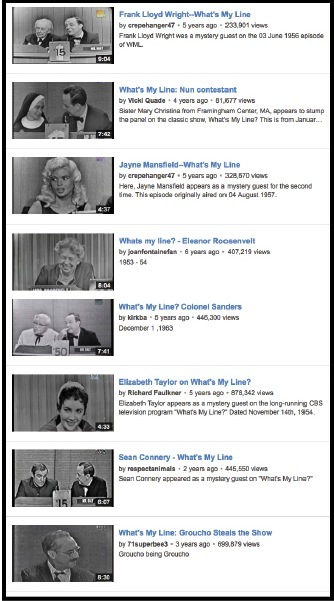
Oh my America!
n
n
I once saw Johnny Rotten on “Judge Judy.” That was surreal, too.
http://youtu.be/fJ2Xb4wgCL0
He lost. Waxing jurisprudential, he had this to say:
His appearances of American television were about as tedious as he seemed to think them triumphant — as when he was thrown off Roseanne Barr’s “Rozanne” show on 7 October 1999:
Rotten — John Lydon before and after his Sex Pistols days — says he had received an OK from the show to bring along his own film crew, but some disagreement arises about that. Lydon says he has received an instruction: “I’m not to be rude to Roseanne. Isn’t that damn hilarious? She’s about the rudest woman on earth.” (If he’d had YouTube and could watch back, he might have realized how much this was a misreading of Barr.)
A producer: “I didn’t want you to say anything derogatory about her, within reason.”
The dependably tiresome Mr. Lydon: “You will not censor me. If I say anything derogatory it’s because she’ll deserve it. If she’s polite, she’ll deserve that, too,” he says to the imperious/fawning exec.
The show’s executive producer turns up, tries to usher Lydon’s film crew away from her delicate negotiations, and tells Lydon: “Come here.”
Lydon: “Don’t talk to me like I’m a lap dog: “Come here”! Who the hell do you think… No, come here.”
He confides to us: “Well, it appears they won’t let us film rehearsals, and they’re pulling attitude with us.”
Stage right, off; an administrator voice: “Can you get security, please.”
Those ignominious, go-to power-wielders’ words.
The security manager manhandled Lydon off the property.
He survived the affront, and Oprah’s lieutenant’s power play, to be tiresome with the tiresome host of “Politically Incorrect”:
http://www.youtube.com/watch?v=vENcA72xKT8
Material like this is with any luck also housed carefully in proper archives, but it’d be hard to deny the pleasure or perhaps it’s just distraction of jumping from, say, Dali, to Rotten, to… You name it.
If you’ll excuse me, I have to keep working through my “watch later” queue. Top 50 Best Implosions/Explosions compilation, a.k.a. (given how many of them are sports stadiums) How to Extort Millions from City and State Governments So You’ll Stay. For the demolition fetishist, Deomolition Fails (Deadly and Dramatic). Enormous Russian Military Ship Plows Onto Crowded Beach. Scariest Sinkholes Known to Mankind. Top 10 Places You Can’t Visit. New Body Part Discovered. How Houdini Died (in slow motion). AK-47 Underwater at 27,450 Frames Per Second. How to Beat Flappy Bird. All Utterly Bloody Useless.
But somewhere there’s a Jimmy Carter on “What’s My Line.” Perhaps it can throw light on his Central America policy, always so perplexing.
Previous Post: "Cousin Jules"— A Rural Life
Next Post: Cinema from the Sun

